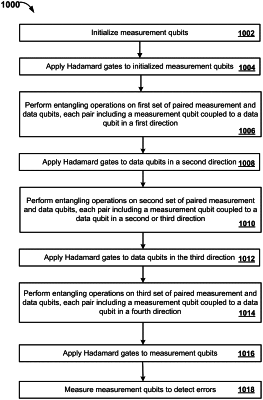| CPC G06N 10/00 (2019.01) [H03K 19/177 (2013.01)] | 2 Claims |

|
1. A method for performing a surface code error detection cycle on a system comprising a plurality of data qubits that perform a quantum computation, the method comprising:
performing multiple entangling operations on a first set of paired measurement and data qubits, wherein each pair in the first set of paired measurement and data qubits comprises a measurement qubit coupled to a neighboring data qubit in a first direction and wherein performing multiple entangling operations on the first set of paired measurement and data qubits comprises separating the pairs into multiple subsets of paired qubits, the multiple subsets comprising non-overlapping and nonadjacent pairs;
performing multiple entangling operations to a second set of paired measurement and data qubits, wherein each pair in the second set of paired measurement and data qubits comprises a measurement qubit coupled to a neighboring data qubit in a second or third direction, the second and third direction being perpendicular to the first direction, the second direction being opposite to the third direction; and
performing multiple entangling operations to a third set of paired measurement and data qubits, wherein each pair in the third set of paired measurement and data qubits comprises a measurement qubit coupled to a neighboring data qubit in a fourth direction, the fourth direction being opposite to the first direction.
|